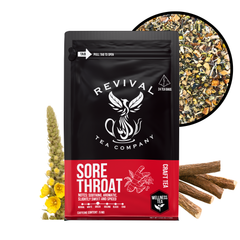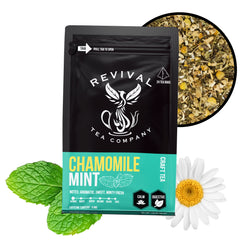Key Takeaways:
- Ingredient Quality Matters: Choosing the best tea for sore throat starts with natural, purpose-driven ingredients like chamomile, licorice root, and ginger.
- Brewing Technique Impacts Relief: Proper water temperature, steeping time, and portion control enhance flavor and comfort in every cup.
- Flavor and Function Can Coexist: From bold ginger peach to soothing chamomile mint, Revival Tea offers blends that feel good and taste even better.
How does something as simple as a dry tickle in your throat manage to hijack your entire day? One moment you're fine; the next, every word feels like sandpaper. Whether it's from a long meeting, the change of seasons, or just bad luck, a sore throat can silence more than your voice—it can slow your whole flow.
At Revival Tea Company, we’re not just in the tea business—we’re making you feel like yourself again. With a reputation for blending function with flavor, our teas are built to be part of your daily rhythm. No fluff, no filler—just thoughtfully chosen ingredients that work together to deliver comfort when needed. And when it comes to finding the best tea for sore throat relief? That’s where we shine.
In this piece, we’re breaking down the top teas that bring serious comfort when your throat begs for a break. If you’re ready to discover blends that live up to the hype, you’re in the right place.
Why Tea Is A Trusted Remedy For Sore Throats
There’s something universally comforting about a warm cup of tea, especially when your throat feels dry, scratchy, or just off. Beyond its warmth and hydration, tea has long been a go-to for those seeking a natural way to unwind when they’re not feeling 100%.
When finding the best tea for sore throat relief, the key isn’t just temperature—it’s what’s in your cup. From soothing herbal blends to gently spiced infusions, tea creates a calming ritual many turn to for comfort during cold-weather seasons or post-concert voice fatigue.
While we’re not making any promises, there’s a reason people have reached for a warm cup of tea for generations. It’s a comforting ritual—easy, soothing, and just the thing to take the edge off a long day, especially when your voice needs a moment of rest.
What To Look For In The Best Tea For Sore Throat Relief
Finding the best tea for sore throat relief isn’t just about grabbing the first herbal blend off the shelf. The right tea should do more than taste good—it should feel intentional, well-crafted, and comforting from start to finish. Here’s what to keep in mind when choosing a blend that delivers:
- Purpose-Driven Ingredients: When your throat’s feeling off, every ingredient counts. Herbs like chamomile, licorice root, and marshmallow root are often added for their naturally soothing properties and how they feel going down. Look for blends highlighting these botanicals as the stars, not just supporting characters.
- Format That Fits Your Flow: Loose leaf or bagged? Each has its strengths. Loose leaf tea offers a deeper, richer flavor and more room for high-quality ingredients to shine, while bagged tea is your go-to for convenience and consistency on the move.
- Caffeine Content That Matches Your Moment: Caffeine might not be top of mind, but it plays a role, especially if you’re winding down for the night. Teas with little to no caffeine are ideal when you want comfort without stimulation, while low-caffeine options offer a light boost if you're sipping midday. It’s all about aligning your tea with the time of day and how you want to feel.
- Flavor That Comforts, Not Overpowers: A sore throat changes how things taste—and how much you enjoy them. Look for teas with naturally mellow, warming, or slightly sweet profiles that feel gentle rather than sharp. Think cinnamon, orange peel, or a soft touch of mint—blends that soothe without stealing the spotlight.
Top Herbal Ingredients That Help Soothe Your Throat
The ingredient list tells the real story when searching for the best tea for sore throat relief. Certain herbs and botanicals show up again and again—not because of trends, but because they’ve earned their place in the blend. Here are some of the standouts that make every sip feel a little more restorative:
- Licorice Root: Sweet, smooth, and slightly earthy, licorice root brings a natural richness to any blend. Thanks to its naturally soothing texture and ability to round out more intense flavors, it's a go-to for throat-focused teas. Whether front and center or in the background, it’s a quiet powerhouse in many comfort blends.
- Chamomile: Known for its calming vibe, chamomile is more than a bedtime tea staple. Its floral softness makes it perfect for soothing moments, especially when your voice feels worn. It pairs effortlessly with bolder ingredients, helping to balance the overall feel of the tea.
- Marshmallow Root: Don’t let the name fool you—this root isn’t sweet like the snack, but it’s just as comforting. It adds a smooth, almost silky feel to tea that’s incredibly welcome when your throat feels raw. It’s one of those ingredients that doesn’t shout, but always makes its presence known.
- Ginger: Spicy and invigorating, ginger wakes up your palate and adds warmth to every sip. It brings depth to throat teas and helps cut through blends that might otherwise feel flat. A little goes a long way, and when it’s done right, it adds serious character to your cup.
The Best Teas To Sip When You’ve Got A Sore Throat
When your throat feels scratchy, dry, or irritated, reaching for the right tea can make all the difference. Revival Tea Company's Sore Throat Tea stands out as a thoughtfully crafted blend designed to bring comfort, clarity, and warmth when you need it most.
Sore Throat Tea by Revival Tea Company
Revival Tea Company’s Sore Throat Tea is a go-to for throat relief, thanks to its unique combination of soothing botanicals and revitalizing green tea. Unlike typical herbal-only teas, this one features a green tea base—providing a gentle lift—while supporting herbs like slippery elm bark, marshmallow root, licorice root, and cinnamon work to coat and calm the throat. There’s also orange peel and lemongrass to brighten the flavor, resulting in a cup that’s both comforting and lively. Slightly sweet, mildly spiced, and unmistakably smooth, it’s the kind of tea that doesn’t just ease symptoms—it becomes part of your wellness ritual.
How To Brew Your Tea For Maximum Relief
Even the best tea for a sore throat can fall flat if not brewed right. How you prepare your cup plays a big role in unlocking your blend's full flavor, texture, and comfort. Here's how to get the most out of every sip:
Use The Right Water Temperature
Because this tea contains green tea alongside roots and spices, you’ll want to strike a balance. Heat your water to around 190–200℉—hot enough to draw out the benefits of the herbs without scalding the delicate green tea base.
Measure With Intention
Use about one teaspoon of loose leaf tea per 8 ounces of water, or follow Revival’s brewing guidelines if you're using a pre-measured portion. Proper measuring ensures a consistent cup that soothes every time.
Let It Steep—But Not Too Long
For this hybrid blend, 4–5 minutes is the sweet spot. It’s long enough to extract the flavors and benefits from the herbs without overwhelming the green tea’s natural brightness. You’ll end up with a balanced, mellow cup that’s smooth going down.
Final Thoughts
When your throat feels off, a warm cup of tea can be more than just a drink—it becomes part of your recovery ritual. Choosing the best tea for sore throat means picking blends that bring comfort and quality, from the ingredients inside to how they brew in your favorite mug.
Whether you’re drawn to floral notes, crave a citrusy punch, or reach for something earthy and grounding, a blend speaks your language. The key is finding a tea that feels good, tastes great, and fits effortlessly into the moments you need it most.
Read also:
- Green Tea Vs Black Tea: Benefits, Caffeine & Flavor Compared
- Creating Your Own Signature Tea Blend
- How to Brew the Perfect Cup of Matcha
Frequently Asked Questions About Best Tea For Sore Throat
How often can I drink tea for a sore throat?
Depending on your comfort and caffeine sensitivity, you can enjoy sore throat tea a few times a day. If the blend is caffeine-free or low-caffeine, it’s gentle enough for regular sipping. Always listen to your body and hydrate throughout the day.
Are fruity teas good for sore throats?
Yes, teas with ingredients like peach, orange peel, or lemon can offer a refreshing twist while still being gentle on your throat. These flavors often pair with warming ingredients like ginger for a balanced cup. The fruit notes add brightness without being harsh.
Does tea lose its soothing quality if I add sweeteners?
Adding a bit of honey or a natural sweetener won’t cancel out the soothing experience. Honey is often a favorite addition for those with throat discomfort. Just avoid overly sugary syrups that can overpower the flavor.
How should I store my tea to keep it fresh?
Keep your tea in an airtight container away from light, moisture, and strong odors. A cool, dry pantry is ideal for maintaining freshness and potency. Proper storage ensures that your tea delivers the same comfort every time.
Is it better to sip tea slowly or drink it quickly when my throat is sore?
Slow sips allow the warmth and flavors to gently coat your throat, offering more sustained comfort. Drinking too fast might miss the relaxing experience that tea can offer. Take your time and make it part of your self-care moment.
Is there a best time of day to drink sore throat tea?
Many people prefer morning and evening, but anytime your throat feels irritated is the right time. Opt for low-caffeine blends at night to avoid interrupting sleep. Match the tea to your schedule and your body's needs.
Can I reuse the same tea leaves or bag for multiple cups?
Some high-quality loose leaf teas can handle a second steep, but the flavor will be lighter. For best results, especially when your throat needs full comfort, use fresh leaves or a new bag. That way, you’ll get the full benefit of the blend.
Should I avoid certain ingredients in sore throat teas?
Check the ingredient list closely if you're sensitive to strong spices or allergens like fennel or licorice. Some blends may contain herbs that can be too intense for certain palates. Stick with clean, familiar ingredients if you're unsure.
How do I know if a tea is actually high-quality?
Look at the ingredient list—fewer fillers and more whole herbs are good signs. High-quality teas also have a stronger aroma and a more vibrant flavor profile. Revival Tea’s handcrafted blends are a great example of quality done right.








